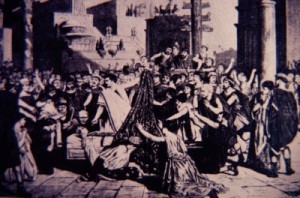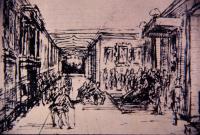A contemporary of Wagner, George II’s work and philosophy occasionally echoed the composer’s. Wagner’s artistic pursuit of Gesamtkunstwerk, meaning “total work of art”, is deeply founded in the Duke’s work. Both artists viewed the theatre as a unified piece of art. This view led directly to the Duke’s formation of the role of director in the theatre, which he acted as in his own company. He saw a need for an ultimate leader to oversee every aspect of the drama, in order for it to be a unified, complete piece of art. This director role is still an integral part of theatre-making today as it was defined and created by the Duke.
In addition to his origination of the art of directing, George II established the norm of having long, working rehearsals with a full cast and ensemble. Along with rehearsals, George II put a strong emphasis on ensemble acting, and created new techniques for staging these ensembles in crowd and mass scenes. Again, this practice of rehearsing remains crucial to production today.
As both a director and a designer, the Duke emphasized realistic portrayal and imitation. He insisted upon historical accuracy, and began to move away from scenic flats and into varied levels and 3-dimensionality of the stage. In this way, George II set the stage for the iconic work of set designer Adolphe Appia.
Arguably, George II, duke of Saxe-Meiningen’s largest contribution to the theatre is the influence that he had on other theatre artists, namely Realists Konstantin Stanislavski and Andre Antoine.


